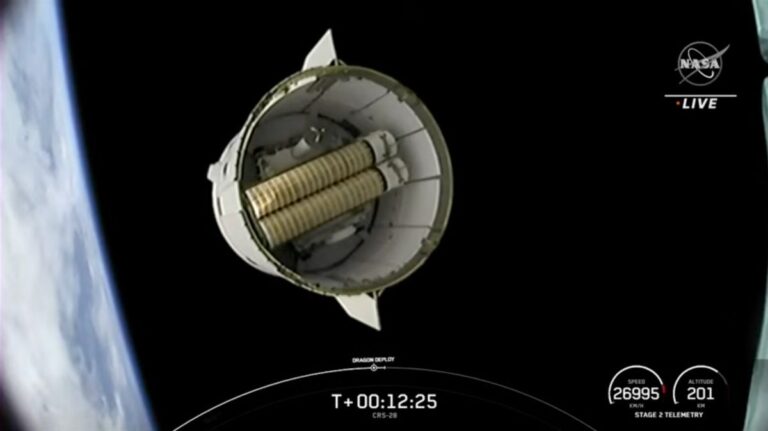
[ad_1]
A SpaceX Dragon cargo capsule will arrive at the International Space Station early Tuesday morning (June 6), and you can watch the action live.
The robotic Dragon launched atop a SpaceX Falcon 9 rocket on Monday (June 5) from NASA’s Kennedy Space Center in Florida. It’s schedule to dock at the space-facing port of the orbiting lab’s Harmony module on Tuesday at 5:50 a.m. EDT (0950 GMT), ending an 18-hour orbital chase.
You can watch the off-Earth rendezvous here at Space.com, courtesy of NASA, or directly via the space agency. Docking coverage will start at 4:15 a.m. EDT (0815 GMT) on Tuesday.
Related: 8 ways that SpaceX has transformed spaceflight

The current Dragon mission is called CRS-28, because it’s the 28th flight SpaceX is flying for NASA under a series of Commercial Resupply Services contracts.
The capsule is hauling about 7,000 pounds (3,175 kilograms) of supplies, scientific experiments and other gear to the International Space Station. Among that hardware are two more International Space Station Roll Out Solar Arrays, or iROSAs, which will be installed on the orbiting outpost’s exterior by spacewalking astronauts to augment its power output.
Getting all the iROSAs up and running will boost the ISS’ electricity generation by 20% to 30%, NASA officials have said.
The science gear includes a technology demonstration for autonomous space station docking systems called CLINGER and Genes In Space-10, which will test a way to measure the length of telomeres in microgravity.
Telomeres are regions of DNA at the end of a chromosome. Telomeres shorten as a person gets older, a phenomenon associated with the onset of some cancers and other diseases, as well as general age-related decline.
Dragon is expected to stay at the ISS for 21 days on CRS-28, then come back down to Earth for a parachute-aided ocean splashdown.
Dragon is the only cargo craft capable of making such safe returns. The other two currently operational robotic freighters — Russia’s Progress vehicle and Cygnus, which is built by American company Northop Grumman — are designed to burn up in Earth’s atmosphere when their time in orbit is done.
[ad_2]